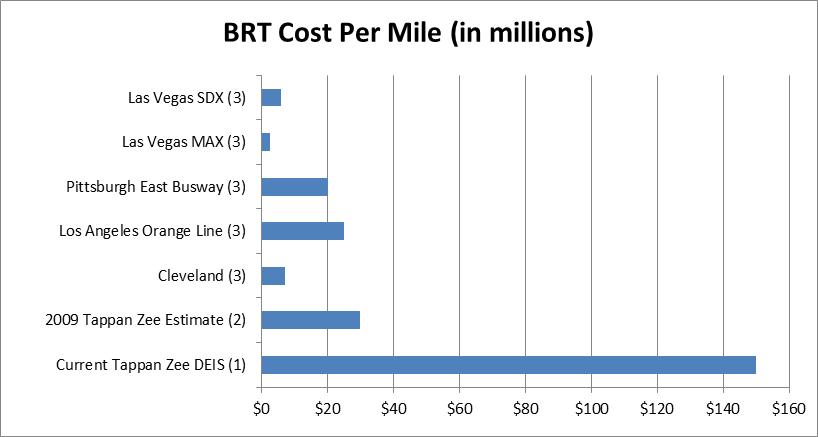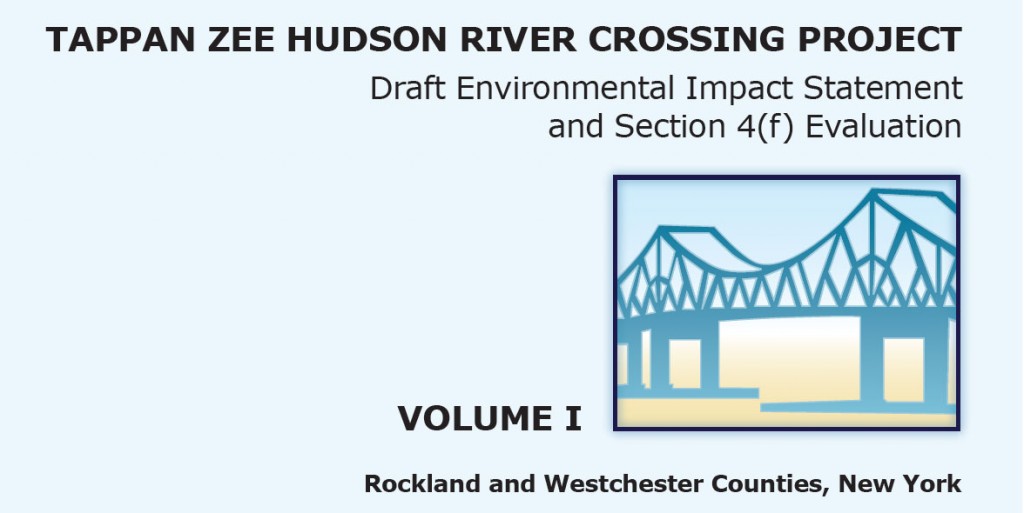In January, the New York State Department of Transportation (NYSDOT) and New York State Thruway Authority (NYSTA) released the Draft Environmental Impact Statement (DEIS) for the Tappan Zee Bridge replacement. Despite popular demand for better public transit in the I-287 corridor, the project’s DEIS makes few provisions for public transportation in the Lower Hudson Valley. Many residents want a bus rapid transit (BRT) system, and Tri-State has set up a website to advocate for BRT’s place in the project. With the March 30 public comment deadline approaching, the call for transit has sounded loud and clear.
This is the fifth and final installment of a series of Mobilizing the Region posts that explain why the state is wrong to conclude that the Tappan Zee should be built without bus rapid transit. Today, we examine why a bridge without public transit cannot fulfill the purpose of the project, as defined by the state in the DEIS.
The first chapter of the Tappan Zee Hudson River Crossing DEIS lays out the purpose and needs behind the project. The section explains the state’s interest in the project by identifying five key problems with the current Tappan Zee that make a replacement necessary: structural deficiencies, operational deficiencies, safety deficiencies, security deficiencies, and mobility deficiencies. The last of these, mobility deficiencies, refers to the auto congestion that plagues the bridge. While a Tappan Zee replacement with or without transit can meet the first four needs, one without transit will not be able to remedy the corridor’s lack of mobility options.
Past and Present State Studies Show That Transit Is Necessary to Improve Mobility
The ten years of study that preceded the current Tappan Zee replacement project found that adding transit is the only way to meet mobility needs on the bridge and in the corridor. An October, 2010, state presentation is unequivocal: “new transit is the only way to relieve congestion and improve mobility in the corridor” (see slide 8).
Furthermore, chapter 21 of the DEIS itself clearly states that “the proposed bridge replacement is not expected to alter regional mobility or capacity.” Rather, the state believes that mobility on the transitless bridge will be marginally increased because there will be fewer accidents, resulting from slightly wider lanes and grading adjustments. That fewer accidents will actually occur seems unclear, considering that 39 locations in the corridor and various entrance and exit ramps have accident rates that exceed statewide averages. In fact, much of the DEIS analysis on accident rates suggests that driver behavior, not lane width, causes most accidents. Page 4-7 notes that 74% of all accidents on the bridge result from unsafe driving practices.
In sum, the bridge designs proposed in the DEIS will barely improve the corridor’s congestion, if at all. The only way to increase mobility on the bridge and in the corridor is by adding transit.
The State Didn’t Study Adding Transit on the Grounds of Cost; This Violates NEPA
Despite state studies showing the importance of transit to the region, New York State continues to say that project alternatives that include public transit will not be evaluated because they are too expensive. This justification is problematic: both National Environmental Policy Act (NEPA) regulations and FHWA guidance state that cost is not an acceptable justification for eliminating an alternative in a project like this one, especially in a large urban area like the I-287 corridor. Accordingly, even if cost is prohibitive – and the state has not shown that it is – the state must still evaluate transit options.
BRT Isn’t Nearly as Expensive as New York Says It Is
The cost of bus rapid transit offered in the DEIS is completely out of line with past state studies, other BRT projects, and the industry average. According to the state, the cost of BRT in the corridor will be between $4.5 and $5.3 billion, but that figure is 4-5 times as much as the $897 million price predicted by the state’s 2009 study. The following chart is a cost per mile comparison with other BRT projects from around the nation, along with the state’s 2009 cost projection: none of the completed BRT systems incurred costs of more than $25 million per mile, yet the current DEIS estimates $150 million per mile.

In sum:
- The DEIS’ alternatives, which lack transit, cannot meet the mobility deficiency problem articulated in the DEIS. As such, the build alternative does not fully address the project’s purpose and needs.
- Making cost the reason for skipping a transit alternative, especially when that cost estimate is unsubstantiated, violates NEPA.
- The cost estimates for transit, which allegedly justify the exclusion of a transit alternative from the DEIS, differ radically from industry standards and previous state studies.
To fix the mobility deficiency in the I-287 corridor, then, the state must consider alternatives with transit. By any metric – mobility, federal law and guidance, cost, environmental benefits – transit must be studied and incorporated into the project.
Sources for graphic:


[…] TSTC: Transit-Free Tappan Zee Won’t Meet Stated Mobility Goal (MTR) […]
[…] TSTC: Transit-Free Tappan Zee Won’t Meet Stated Mobility Goals (MTR) […]
THE WEAR AND TEAR ON THE TZB COMES FROM HEAVY TRUCKING AND WEATHER. UNLESS THE REPLACEMENT MEETS THESE CHALLANGES IT WILL SURELY FAIL. IF THE TAPPAN LONGISLAND TUNNEL IS BUILT(FOR THE SAME MONEY), TRUCKONTRAIN AND HIGHSPEED RAIL SERVICE WILL NEVER BE POSSIBLE. AND REGIONALCONJESTION WILL GO ON WITH ITS ASSOCIATED DEATH TOLL. LETS JOIN THEWORLD, OR AT LEAST BE POLITE.
SORRY- SHOULD READ –IS NOT BUILT–BUT THERE DOES NOT SEEM TO BE ANY INTEREST ANYWAY
[…] Tri-State Transportation Campaign wrote this week that a bridge without transit cannot meet one of the project’s stated […]
[…] from elected officials’ comments in the press release was any mention of transit, even though, according to New York State’s own documents, “New Transit is [the] only way to relieve congestion and improve mobility in the [I-287] […]
[…] But after 40 years of population increases and ever-expanding sprawl development, the TZB and I-287 corridor, which runs through both counties, had developed a serious congestion problem. So much so that in the late 1990s, Governor Pataki formed a task force to study the congestion problem and the possibility of replacing the bridge. That study essentially set in motion a process, which began in 2002, focused on fixing the Lower Hudson Valley’s congestion problem. But it’s clear now that a new bridge alone still will not solve the problem. […]